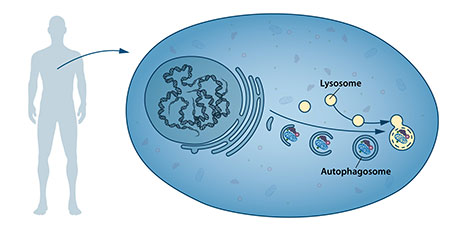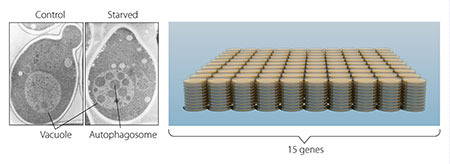Nobel Prize in Physiology and Medicine awarded for the study of "self-eating" cells

This year, the Nobel Prize in Physiology and Medicine became the Japanese scientist Yoshinori Osumi [Yoshinori Ohsumi] for researching the mechanisms of autophagy. The term "autophagy" appeared in the 60s of the last century. It began to be used in relation to the cellular mechanisms of purification of the body from degraded proteins. Scientists have found that using this process, the cell is cleared of intracellular debris, sending it to the lysosomes. Lysosome (from the Greek. Λύσις - dissolving and sōma - the body) is a cellular organoid surrounded by a membrane, in the cavity of which an acidic medium is maintained and there are many soluble hydrolytic enzymes. Lysosome is responsible for the intracellular digestion of macromolecules, including autophagy.
Despite the fact that the process was known to scientists for a long time, its details remained unexplored. In order to study the process of autophagy in detail, Osumi conducted several witty experiments. Almost all of his experiments, he spent on Baker's yeast, trying to identify the genes that are responsible for autophagy. He further compared the mechanism of autophagy in yeast cells with a similar mechanism in human cells. The Japanese managed to show that in our own cells, the process proceeds along roughly the same scenario.
Also, the Japanese scientist made several discoveries, showing that autophagy is very important in various physiological processes. Mutations in the genes responsible for the mechanism of autophagy can lead to the appearance of diseases, including cancer and neurological diseases. Other scientists who took advantage of Osumi’s work found that abnormalities in the mechanism of autophagy can lead to Parkinson's disease, type 2 diabetes, and other diseases. Plus, autophagy plays a significant role in the development of embryos of many creatures. It is also needed in the case of the body's struggle with both bacterial and viral infections.
')
Yeast was chosen by the Japanese for the reason that they can be considered as the simplest eukaryotic system. Here, as mentioned above, there are very few differences in the mechanisms of autophagy with those that work in human cells.
Osumi argues that there are two main ways in which autophagy occurs. The first is the degradation in the proteasome . This is the name of the large multisubunit protease present in the cells of eukaryotes, archaea, and some bacteria. In the eukaryotic cells of the proteasome are contained in the nucleus and in the cytoplasm. The main task of the proteasome in the body is the proteolytic degradation of unwanted and damaged proteins to short peptides (4-25 amino acid residues), which can then be split into individual amino acids. The work of the proteasomes was studied in the 70s / 80s of the last century. In 2004, Aaron Ciechanover, Avram Hershko and Irwin Rose won the Nobel Prize for clarifying the details of protein degradation in the proteasomes.

The second way was already mentioned above - this is the destruction of proteins in special organelles, which are bubbles surrounded by a membrane. Such organelles are called lysosomes. Lysosomes were discovered in the mid 50s of the last century. The discovery of lysosomes was awarded the Nobel Prize in Physiology and Medicine, which in 1974 received the Belgian scientist Christian de Duve [Christian de Duve]. This scientist was the first to introduce the term “autophagy.”
Yoshinori Osumi was able to bring out a special type of yeast that accumulated autophagosomes during the fasting process. After that, he acted on the genetic apparatus of the yeast with a certain chemical substance that caused random mutations, and did not give the yeast enough nutrients. In the normal cell of the yeast bred by the Japanese, in this case, the process of autophagy was launched. In cells that have undergone mutations, this process sometimes did not work. The scientist suggested that in this case the gene responsible for autophagy was damaged. As a result, Osumi was able to disable various yeast DNA genes, observing the effects of a shutdown. Through trial and error, he managed to find those genes without which the cells could no longer trigger the “self-feeding” mechanism. As it turned out, there are fifteen such genes in the yeast genotype. In any case, this is all that was found.

The research of the Japanese scientist was recognized by the Karolinska Institute, which presented the Nobel Prize, as outstanding. “Osumi’s discoveries have been able to give us an understanding of how cells process themselves and how they are cleared of protein debris. The work of the scientist opened a new direction in the understanding of autophagy as part of a wide variety of physiological processes, including the reaction to infection and adaptation to hunger, ”the Karolinsky Institute press release said .

Yoshinori Osumi’s research triggered a boom in autophagy research and a corresponding increase in the number of publications on this topic. The extent to which the work of Osumi had a strong influence can be judged according to the schedule presented above.
Source: https://habr.com/ru/post/398099/
All Articles